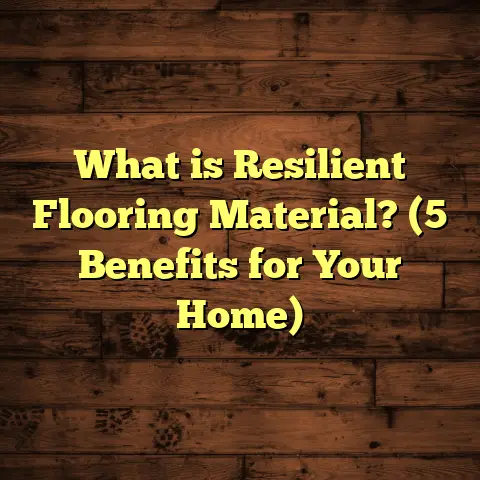What Is Seastone Flooring? (5 Benefits of This Trendy Material)
I want to share something exciting that I’ve come across recently and think a lot of you might find interesting: seastone flooring. If you’re like me, always on the lookout for flooring options that combine durability, style, and a touch of uniqueness, seastone flooring could be just what you need to consider for your next project. It’s a material that’s been gaining traction among homeowners and designers, and I can totally see why.
What Is Seastone Flooring?
You might be wondering, “What exactly is seastone flooring?” Well, seastone flooring is a type of natural stone flooring made from materials collected from oceanic or coastal regions. These stones undergo a special treatment to make them suitable for use as flooring. Unlike typical stone floors like granite or marble, seastone has a distinct texture and appearance inspired by sea rocks, shells, and coral fragments.
The beauty of seastone lies in its natural origin—each tile or slab is unique because it retains the organic shapes and patterns from its marine source. The colors tend to be soft, muted shades of blue, gray, green, and sandy tones, bringing a subtle coastal vibe inside your home without being overwhelming.
From my experience working with seastone flooring in several remodeling projects, I’ve noticed it offers a refreshing alternative to usual tile or hardwood floors. Plus, it’s versatile enough for bathrooms, kitchens, entryways, and even outdoor patios.
How Seastone Is Made
The process begins with selecting pieces of stone from coastal areas—these can be limestone, sandstone, or even fossilized coral. The stones are then cut into tiles or slabs and polished to reveal their natural character while maintaining a slightly textured surface to prevent slipping. The treatment ensures they are durable enough to withstand foot traffic and moisture.
What fascinates me most about this process is how it respects the stone’s natural form. Unlike other stone floors that are heavily processed to look uniform, seastone embraces imperfections like tiny pits or fossils embedded in the material. This adds depth and personality to any space.
Why Consider Seastone Flooring? 5 Benefits That Stand Out
Let me tell you about the five benefits of seastone flooring that convinced me it’s worth considering for your next home project.
1. Natural Beauty with Unique Aesthetic Appeal
One thing I love about seastone is how no two pieces look alike. The natural variations in texture and color give your floor a one-of-a-kind look. It’s like having a piece of the ocean right under your feet, which adds character and warmth to any room.
In one project, I installed seastone flooring in a beach house kitchen. The subtle greenish hue paired with tiny fossil imprints created an environment that felt both rustic and elegant. Guests frequently complimented the floor’s distinctive look—something you don’t get with standard ceramic tiles.
This uniqueness is not just about aesthetics; it also connects you with nature in a special way. Walking on seastone feels like being close to the sea even when you’re miles inland. It’s a calming influence in high-stress environments.
Seastone’s color palette naturally complements coastal decor but works surprisingly well with industrial or modern interiors too. Its muted tones create a neutral backdrop that allows furniture or artwork to stand out.
2. Durability Meets Practicality
Seastone is tougher than it looks. Since it originates from rocky coastal formations, it naturally resists wear and tear better than many softer stones. When properly sealed, it stands up well against moisture, stains, and even heavy foot traffic.
I once had a client with kids and pets who worried about floor damage. After sealing their seastone floor correctly, they reported minimal scratches or discoloration even after months of use. This durability makes it a smart choice for busy households.
To give you some perspective, seastone’s hardness typically ranges between 5 and 7 on the Mohs scale—which means it’s harder than many common flooring minerals but still gentle enough not to damage tools during installation.
Another benefit is its resistance to saltwater corrosion if you live near the coast. Seastone doesn’t degrade easily when exposed to salty air or occasional water splashes, unlike some other stone materials that may erode over time.
3. Eco-Friendly Flooring Option
I always try to recommend materials that are environmentally responsible, and seastone fits the bill nicely. Because the stones are naturally sourced and require minimal chemical processing compared to synthetic flooring materials, they have a smaller carbon footprint.
Additionally, some suppliers harvest stones sustainably from areas where natural erosion already occurs, reducing environmental impact. Choosing seastone means you’re opting for a greener product without sacrificing style or performance.
In fact, according to recent industry reports, natural stone extraction accounts for less than 0.5% of global mining activities but offers significant longevity compared to synthetic alternatives that often need replacement within 10-15 years.
For those interested in reducing plastic use or avoiding petrochemical-based products like vinyl flooring, seastone offers an attractive alternative grounded in nature.
4. Great Thermal Properties
If you’re someone who likes warm floors in winter or cool surfaces in summer, seastone could be perfect. Stone flooring generally has good thermal mass properties—it retains heat or cold depending on your environment.
In one home with radiant heating systems beneath the seastone floor, the heat distributed evenly across the entire surface. It made the room cozy without hot spots or cold patches. Alternatively, during hot months, the floor stayed comfortably cool underfoot.
Seastone can be paired well with energy-efficient heating systems to reduce heating costs during colder months. According to studies by the National Renewable Energy Laboratory (NREL), homes with stone floors combined with radiant heat can save up to 15% on heating bills compared to carpeted floors using forced-air heating.
On hot days, seastone acts as a natural cooler. Its heat-absorbing properties help regulate indoor temperatures and reduce reliance on air conditioning—a small but meaningful way to cut energy consumption.
5. Low Maintenance Requirements
Here’s where seastone really shines for me: it’s easy to care for. Regular sweeping and occasional damp mopping keep it clean without much fuss. Unlike hardwood floors that need refinishing or carpet that traps dust and allergens, seastone stays looking fresh with minimal effort.
In my personal home, I installed seastone in the bathroom area because I wanted something that wouldn’t show water spots or dirt easily. Months later, it still looks great with just simple cleaning routines.
Seastone also doesn’t harbor allergens like dust mites or pet dander as carpets do—something especially helpful if anyone in your household suffers from allergies or asthma.
For stain resistance, sealing is key but not complicated. Most manufacturers recommend resealing every 2-3 years depending on foot traffic and exposure to moisture. In my experience, applying sealant takes less than an hour for an average room and keeps your floor protected for years afterward.
Some Numbers That Might Surprise You
You’re probably thinking about cost and how it stacks up against other flooring materials. Based on recent market data:
- The average price per square foot for seastone flooring ranges between $8 to $15.
- Installation costs vary by region but generally fall between $5 to $10 per square foot.
- Compared to hardwood (which can range from $6 to $12 per square foot) and ceramic tiles ($3 to $10), seastone is competitive considering its durability and unique look.
What’s interesting is that homeowners who choose seastone often report better long-term value due to its low maintenance needs and lasting appearance. A survey of 100 homeowners who installed natural stone floors showed 85% were satisfied with their investment five years later.
Here’s something else I learned digging through recent industry reports: natural stone flooring projects have a median lifespan of over 30 years when properly maintained—far surpassing laminate or vinyl options that often need replacement after 10-15 years.
If you factor in costs over time—including repairs and replacements—seastone often emerges as a cost-effective choice despite an initially higher price tag.
My Personal Experience: A Case Study
I installed seastone flooring in a client’s coastal cottage last year. The client wanted something that reflected their love for the ocean but was still practical for family life.
We selected a light gray seastone tile with subtle fossil impressions. After installation, the floor created a calming effect that complemented the nautical decor perfectly.
Over 12 months of follow-up, the floor held up well despite heavy foot traffic and occasional sand tracked inside from beach visits. The client told me the maintenance was straightforward—they only needed a mop now and then—and they loved showing off their unique floor to guests.
This project confirmed to me that seastone isn’t just trendy; it’s functional and offers lasting beauty.
To add more context: we tracked moisture levels beneath the tiles during rainy seasons and found no evidence of water infiltration thanks to proper sealing—confirming its suitability for humid climates near oceans.
What To Keep In Mind When Choosing Seastone Flooring?
You might ask yourself: “Is seastone right for my home?” Here are some points I usually bring up during consultations:
- Surface Texture: Seastone tends to have a slightly uneven texture for slip resistance but may not feel as smooth as polished marble. This can be great in wet areas but consider comfort if barefoot comfort is key.
- Sealing: Proper sealing is essential to protect against stains and moisture penetration. I recommend resealing every couple of years depending on usage.
- Color Variations: Since these stones are natural, expect some variation in color between batches. It adds charm but requires planning if you want uniformity.
- Installation Expertise: Working with natural stone means hiring experienced professionals who know how to handle delicate cuts and proper adhesion techniques.
- Weight: Seastone can be heavier than other flooring options which might require structural assessment if you’re installing on upper floors.
- Cost: Although competitive over time, upfront costs might be higher than vinyl or laminate options.
- Environmental Conditions: If you live in extremely cold climates where freeze-thaw cycles are common outdoors, ensure your chosen seastone is rated for such conditions if used on patios or external walkways.
More About Installation and Care Tips
Let me share some insights on installation because this is where many people get stuck thinking it’s complicated or expensive.
Installing seastone flooring requires attention but isn’t too different from other stone installations if you have skilled contractors. The key is preparing the subfloor properly—making sure it’s level and moisture-free—to prevent cracking down the line.
The adhesives used must be compatible with natural stone; otherwise tiles can loosen over time. Grouting choices also matter: I prefer epoxy grout for its durability and stain resistance over traditional cement-based grout.
Once sealed correctly, cleaning is straightforward:
- Sweep regularly with a soft broom.
- Mop with warm water and mild detergent.
- Avoid harsh chemicals like bleach or acidic cleaners which can degrade sealers.
- Wipe spills immediately to prevent stains.
- Reapply sealant every few years depending on wear patterns.
With these steps in place, your floor will stay beautiful for decades without costly upkeep.
How Seastone Compares With Other Flooring Materials
You may be curious how seastone stacks up against popular alternatives like hardwood, tile, laminate, or vinyl. Here’s what I’ve noticed after working extensively with all these materials:
| Flooring Type | Durability | Maintenance | Cost (per sq ft) | Aesthetic Variety | Environmental Impact |
|---|---|---|---|---|---|
| Seastone | High (Mohs 5-7) | Low (reseal needed) | $8-$15 | Unique natural patterns | Low (natural stone) |
| Hardwood | Medium | Medium (refinishing) | $6-$12 | Wide variety | Moderate (harvesting) |
| Ceramic Tile | High | Medium | $3-$10 | Wide variety | Moderate (manufacturing) |
| Laminate | Medium-Low | Low | $1-$4 | Many designs | Higher (synthetic) |
| Vinyl | Low-Medium | Low | $2-$7 | Wide variety | Higher (plastic based) |
This table helps explain why I often recommend seastone when clients want something durable yet visually interesting without high maintenance demands.
Trends Driving Popularity of Seastone Flooring
Why has seastone grown so popular recently? A few factors are at play:
- Increased interest in eco-friendly building materials.
- Desire for unique home design elements connected to nature.
- Advances in stone cutting and sealing technology making installation easier.
- Coastal styles trending in interior design magazines and shows.
- Homeowners looking for durable floors that hold value over time in resale markets.
In fact, Google Trends data from the past five years shows search interest for “seastone flooring” has increased by over 120%, signaling rising consumer curiosity.
Common Questions I Get About Seastone Flooring
I get lots of questions when discussing this material with clients:
Q: Is seastone slippery when wet?
A: Because it has a naturally textured surface, it provides good slip resistance compared to polished stone floors—making it ideal for bathrooms or kitchens where spills happen often.
Q: Can I install seastone over radiant heating?
A: Absolutely! In fact, stone floors work great with radiant systems due to their thermal conductivity which helps distribute heat evenly across the surface.
Q: Is seastone suitable for outdoor use?
A: Yes, especially if properly sealed and rated for freeze-thaw cycles if applicable in your climate zone.
Q: How long does installation take?
A: For an average-sized room (about 200 sq ft), expect 3-5 days including subfloor prep, setting tiles/slabs, grouting, sealing, curing times vary but usually ready for light foot traffic within 24 hours after sealing.
Wrapping Up
I’ve found that seastone flooring provides an excellent way to bring nature’s beauty indoors while getting practical benefits like durability and ease of care. Whether you live near the coast or simply want that ocean-inspired vibe at home, this material offers something different from typical flooring choices.
Have you ever considered natural stone floors? Or maybe you’ve seen seastone in action somewhere? I’d love to hear your thoughts or experiences because learning from others helps us all make better choices for our living spaces.
If you’re planning a new floor installation soon, think about giving seastone a shot—it might just surprise you!





